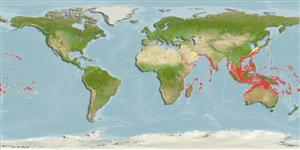Environment: milieu / climate zone / depth range / distribution range
экология
морской ассоциированный с рифами; пределы глубины 0 - 180 m (Ref. 9710). Tropical; 35°N - 31°S, 33°E - 134°W (Ref. 55)
Indo-Pacific: East Africa to the Hawaiian Islands, north to southern Japan, south to Australia.
Length at first maturity / Size / Вес / Возраст
Maturity: Lm 45.0, range 42 - 50 cm
Max length : 112 cm TL самец/пол неопределен; (Ref. 7196); common length : 90.0 cm TL самец/пол неопределен; (Ref. 5450); наибольший вес (опубликованные данные): 15.4 kg (Ref. 40637); наибольший возраст (опубликованны данные): 32 годы (Ref. 125573)
колючие лучи спинного плавника (общее число) : 10; членистые (мягкие) лучи спинного плавника (общее число) : 11; колючие лучи анального плавника: 3; членистые (мягкие) лучи анального плавника: 8. This species is distinguished by the following characters: body elongate and robust; very distinct horizontal groove on snout ventral to nostrils; teeth in both jaws in bands, with strong canines anteriorly; teeth on roof of mouth in chevron- or crescent-shaped patch on vomer and in elongate band on each palatine; maxilla without scales or longitudinal ridges; interorbital region flattened; gill rakers on first gill arch 7-8 + 13-16 = 20-24; preopercular edge smooth, sometimes denticulated in juveniles; last soft ray of both dorsal and anal fins well produced, longer than next to last ray; caudal fin forked; short pectoral fins, less than 1/2 length of head, about equal to length of snout; D X,11 soft rays; membranes of dorsal and anal fins without scales; tubed lateral-line scales 48-50. Colour of body dark green, bluish, or grey-blue (Ref. 55, 9821).
Adults inhabit open waters of deep lagoons, channels, or seaward reefs (Ref. 9710). Found in benthopelagic waters (Ref. 58302). Usually seen singly, but also in groups. They feed mainly on fishes, but also on shrimps, crabs, cephalopods and planktonic organisms (Ref. 30573, 48635). Mainly marketed fresh but also dried and salted. Excellent eating. Large individuals may be ciguatoxic (Ref. 37816).
Allen, G.R., 1985. FAO Species Catalogue. Vol. 6. Snappers of the world. An annotated and illustrated catalogue of lutjanid species known to date. FAO Fish. Synop. 125(6):208 p. Rome: FAO. (Ref. 55)
Статус Красного Списка МСОП (Ref. 130435: Version 2024-1)
Угроза для людей
Reports of ciguatera poisoning (Ref. 4690)
Использование человеком
рыболовство: важный объект промысла; объект спортивного рыболовства: да; аквариум: коммерческий
дополнительная информация
инструменты
Специальные отчеты
Скачать в формате XML
ресурсы в Интернет
Estimates based on models
Preferred temperature (Ref.
123201): 23.9 - 29, mean 27.9 °C (based on 2222 cells).
Phylogenetic diversity index (Ref.
82804): PD
50 = 1.0000 [Uniqueness, from 0.5 = low to 2.0 = high].
Bayesian length-weight: a=0.01413 (0.01192 - 0.01674), b=2.94 (2.89 - 2.99), in cm total length, based on LWR estimates for this species (Ref.
93245).
Trophic level (Ref.
69278): 4.3 ±0.4 se; based on diet studies.
Generation time: 3.8 (3.3 - 7.8) years. Estimated as median ln(3)/K based on 12
growth studies.
устойчивость к внешним воздействиям (Ref.
120179): средний (среднего размера), минимальное время удвоения популяции 1.4-4.4 года (K=0.29; tm=4-5).
Prior r = 0.28, 95% CL = 0.18 - 0.42, Based on 1 full stock assessment.
Fishing Vulnerability (Ref.
59153): Moderate vulnerability (40 of 100).
Nutrients (Ref.
124155): Calcium = 19.1 [9.1, 35.8] mg/100g; Iron = 0.514 [0.226, 0.991] mg/100g; Protein = 19.1 [17.2, 20.8] %; Omega3 = 0.153 [0.091, 0.252] g/100g; Selenium = 40.7 [20.9, 75.2] μg/100g; VitaminA = 87.7 [31.2, 272.9] μg/100g; Zinc = 1.56 [0.42, 2.27] mg/100g (wet weight); based on
nutrient studies.
